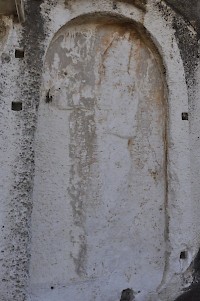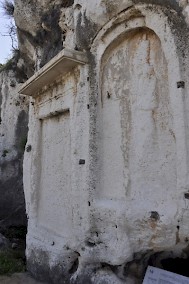Esarhaddon's Nahr al-Kalb Inscription
Esarhaddon's Nahr al-Kalb Inscription: inscription, just north of Beirut in modern Lebanon, documenting the Assyrian conquest of Egypt in 671 BCE.
Assyria and Egypt

In the first quarter of the seventh century BCE, king Esarhaddon (r.680-669) tightened the Assyrian grip on the cities of Phoenicia. In the winter of 677/676, he was able to subdue the powerful coastal city of Sidon and in the next year, he started to demand tribute from the other Phoenician cities. Having in this way secured his rear, and no doubt with the support of a Phoenician fleet, the Assyrian king decided to attack Egypt (674/673).
After a first setback, he was more successful in 671 and forced the Egyptian king Taharqo to abandon Egypt and retreat to his homeland, Nubia. However, Esarhaddon was forced to suppress insurrections in the north. Among the rebels were Ashkelon and Tyre, which Esarhaddon forced into submission. After Essarhaddon's death in 669, his successor Aššurbanipal would in 667/666 gain full control of Egypt, even sacking Thebes.

To make sure that the Phoenician cities better understood that Esarhaddon was and would always be victorious, the king left an inscription at the mouth of the Nahr al-Kalb, opposite one of the reliefs that the Egyptian king Ramesses II had once made to commemorate his Syrian campaigns. Everyone traveling along the coast from Byblos to Beirut would see Esarhaddon's relief and understand that Esarhaddon was a greater conqueror than the heroes of the past.
The inscription
Exposed to the elements, Esarhaddon's relief is now badly damaged, but the general meaning of the text is sufficiently clear, and we're certain that the text ended with a reference to the insurrection of Askhelon and Tyre.
The text, known as ANET 289, was translated by Daniel David Luckenbill.
Esarhaddon: the Conquest of Egypt
[1] [Illegible]
I entered Memphis, his royal residence, amidst jubilation and rejoicing. ... Upon the Sad alum, which was plated with gold, I sat down in happiness. ... weapons, a KURnandti of gold, silver, plates of ... Afterwards, I entered ... and his palace, the gods and goddesses of Taharqo, king of Nubia, together with their possessions ... I declared as booty.
[2] His queen, the female servants of his court, Ušanahuru, the heir to his throne, ...-miri, his court officials, ... his possessions, his ...s inlaid with precious stones, ivory, wooden ..., the plating of which is of gold, their faucets of ... other utensils of gold, silver, ...-stone, ... whatever was in the palace, which had no equal in Assyria and was artfully constructed. And I also opened the chests, the baskets and the ... in which were stored the tribute of his kingdom.
[3] I did ... king ... they had left them behind as well as 16 tiaras, 30 headgears for queens, ...-stone. ... stone slabs ... in large quantities. The treasuries full with gold, silver, antimony, ... byssus-linen, ... the batbat of which is like ... copper, tin, abaru-metal, ivory, ...s of the Suti-people, ... his sons-in-law, his family, ... princes, ... physicians, divination-experts ... goldsmiths, cabinetmakers, ... the son of Binzuqi ... which Taharqo [had made] to their strongholds, ...
[Texts becomes illegible, but the words "Tyre" and "Ashkelon" can be read.]